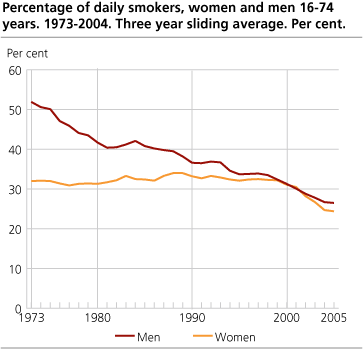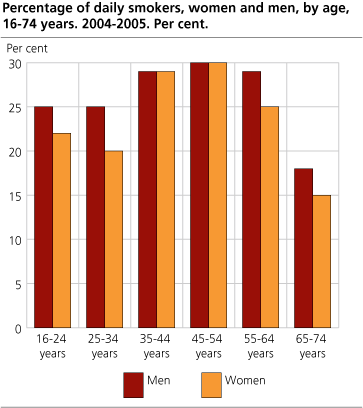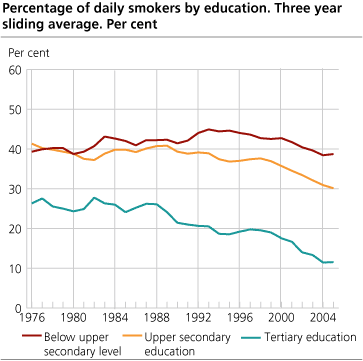Content
Published:
This is an archived release.
One out of four smokes daily
About one out of four people aged 16-74 smoked daily in 2005. In addition, approximately 11 per cent smoked occasionally.
Every year Statistics Norway conducts surveys about the use of tobacco. The 2005 survey shows that 25 per cent of the population aged 16-74 are daily smokers. The proportion was 26 per cent in 2004.
24 per cent of the women answers that they are daily smokers, the corresponding figure in 2004 was 25. Among men, 26 per cent answers that they are daily smokers. The corresponding figure in 2004 was 27. Thus, it might seem that a smaller share of women smoke, but the difference is not statistically significant1. We find the largest proportion of daily smokers among persons aged 35-54, and the smallest shares among the youngest and the oldest.
A reduction from 1998
In 1973, more than half of the adult male population were smokers. Today, the proportion is 26 per cent. From 1973 to 2000, the proportion of female smokers was slightly above 30 per cent. But the share of female smokers is also significantly reduced, and is now 24 per cent. The trend appears to have shifted around 1998. From then on, we observe an equal reduction in the share of smokers among both men and women.
Educational background is an important factor
Education has large effects on the smoking pattern. More than twice the proportion of those with education below secondary level smoke compared to those with tertiary education. The number of daily smokers among those with tertiary education has declined significantly since the mid 1970s. The share among those below secondary level has remained stable. Using this factor in the explanation of the total share of smokers in the population, the change in the level of education in the population as a whole must be taken into consideration. (See http://www.ssb.no/english/subjects/04/01/ )
About the survey
Statistics Norway has conducted surveys on the use of tobacco for more than thirty years. The proportion of smokers is measured by two questions: "Do you sometimes smoke?" and "Do you smoke daily or occasionally?" In the course of one year four Omnibus surveys with a total net sample of 5 000 people are carried out.
There are possible sources of error in any interview survey. Therefore, error margins of more than one percentage point in both directions are used in these surveys. To counteract the effect of random changes in the data, a three-year moving average is used. This has been particularly important when the sample has been smaller than what it is today. A three-year moving average means that the average of the results for three consecutive years is calculated, and that this average represents the second year.
| Percentage daily smokers, by age. 1995-2005. Observed result and estimated three-year sliding average |
| Daily smoker 16-74 years | Daily smoker 16-24 years | ||||||||||||||||||||||||||||||||||||||
|---|---|---|---|---|---|---|---|---|---|---|---|---|---|---|---|---|---|---|---|---|---|---|---|---|---|---|---|---|---|---|---|---|---|---|---|---|---|---|---|
| Observed result | Estimated three year moving average | Sample size (N) | Observed result | Estimated three year moving average | Sample size (N) | ||||||||||||||||||||||||||||||||||
| 1995 | 32.6 | 32.9 | 5 165 | 28.7 | 28.3 | 812 | |||||||||||||||||||||||||||||||||
| 1996 | 33.1 | 33.1 | 5 189 | 28.6 | 29.3 | 854 | |||||||||||||||||||||||||||||||||
| 1997 | 33.6 | 33.2 | 5 305 | 30.6 | 30.1 | 819 | |||||||||||||||||||||||||||||||||
| 1998 | 33.0 | 32.9 | 5 088 | 31.2 | 29.9 | 797 | |||||||||||||||||||||||||||||||||
| 1999 | 32.0 | 32.3 | 4 913 | 27.7 | 30.2 | 783 | |||||||||||||||||||||||||||||||||
| 2000 | 31.9 | 31.2 | 5 004 | 31.5 | 28.7 | 806 | |||||||||||||||||||||||||||||||||
| 2001 | 29.8 | 30.3 | 5 047 | 26.8 | 28.7 | 781 | |||||||||||||||||||||||||||||||||
| 2002 | 29.4 | 28.5 | 5 311 | 27.8 | 25.8 | 819 | |||||||||||||||||||||||||||||||||
| 2003 | 26.3 | 27.3 | 5 094 | 22.8 | 24.8 | 812 | |||||||||||||||||||||||||||||||||
| 2004 | 26.0 | 25.8 | 5 034 | 23.7 | 23.5 | 852 | |||||||||||||||||||||||||||||||||
| 2005 | 25.0 | 125.5 | 5 029 | 24.1 | 123.9 | 833 | |||||||||||||||||||||||||||||||||
| 1 | Average 2004 and 2005. |
The statistics are produced every year on behalf of the Directorate for Health and Social Affairs.
195 per cent confidence interval.
Contact
-
Elin Skretting Lunde
E-mail: elin.skretting.lunde@ssb.no
tel.: (+47) 92 42 70 07
-
Jorun Ramm
E-mail: jorun.ramm@ssb.no
tel.: (+47) 92 08 23 99
-
Arne Jensen
E-mail: arne.jensen@ssb.no
tel.: (+47) 99 71 22 45



